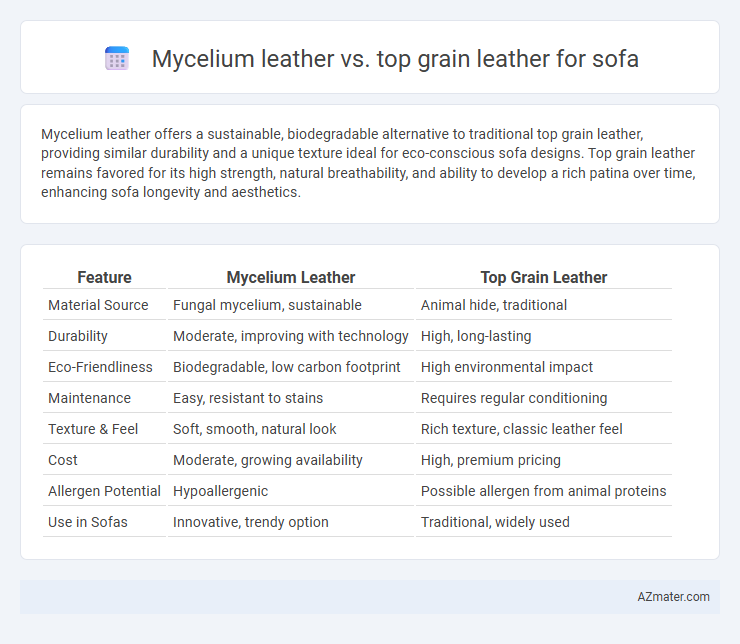Mycelium leather offers a sustainable, biodegradable alternative to traditional top grain leather, providing similar durability and a unique texture ideal for eco-conscious sofa designs. Top grain leather remains favored for its high strength, natural breathability, and ability to develop a rich patina over time, enhancing sofa longevity and aesthetics.
Table of Comparison
| Feature | Mycelium Leather | Top Grain Leather |
|---|---|---|
| Material Source | Fungal mycelium, sustainable | Animal hide, traditional |
| Durability | Moderate, improving with technology | High, long-lasting |
| Eco-Friendliness | Biodegradable, low carbon footprint | High environmental impact |
| Maintenance | Easy, resistant to stains | Requires regular conditioning |
| Texture & Feel | Soft, smooth, natural look | Rich texture, classic leather feel |
| Cost | Moderate, growing availability | High, premium pricing |
| Allergen Potential | Hypoallergenic | Possible allergen from animal proteins |
| Use in Sofas | Innovative, trendy option | Traditional, widely used |
Introduction to Mycelium Leather and Top Grain Leather
Mycelium leather, derived from the root structure of mushrooms, offers a sustainable and eco-friendly alternative to traditional Top Grain leather, which is made from the outermost layer of cowhide known for its durability and premium quality. Mycelium leather's natural texture and biodegradable properties appeal to environmentally conscious consumers, while Top Grain leather remains prized for its strength, smooth finish, and resistance to wear. Both materials provide unique benefits, with mycelium leather advancing innovation in plant-based materials and Top Grain leather maintaining its status as a classic choice for luxury sofas.
Material Origins and Production Processes
Mycelium leather is derived from fungal root systems, cultivated through a sustainable fermentation process that rapidly produces a biodegradable and eco-friendly material. Top grain leather originates from the upper layer of cowhide, undergoing extensive tanning and finishing procedures that enhance durability but involve high water and chemical usage. The contrasting material origins and production methods highlight mycelium leather as a renewable alternative, whereas top grain leather emphasizes traditional animal-based craftsmanship with a significant environmental footprint.
Environmental Impact and Sustainability
Mycelium leather offers a sustainable alternative to top grain leather by using fast-growing fungal biomass that requires significantly less water, land, and energy, reducing greenhouse gas emissions and deforestation. Top grain leather involves resource-intensive animal farming and chemical tanning processes that contribute to high environmental pollution and habitat loss. Choosing mycelium leather for sofas supports circular economy practices and lowers the carbon footprint compared to conventional leather production.
Durability and Longevity Comparison
Mycelium leather offers innovative durability with natural resistance to wear and tear, making it a sustainable alternative to traditional materials. Top grain leather, known for its robust fibers and ability to develop a rich patina over time, typically provides superior longevity and maintains structural integrity for decades. While top grain leather excels in long-term durability, mycelium leather's emerging technology promises comparable strength with enhanced environmental benefits.
Comfort and Aesthetic Appeal
Mycelium leather offers a soft, breathable texture that enhances comfort on sofas, mimicking the natural feel of animal hide while being eco-friendly. Top grain leather provides a smooth, durable surface with a rich patina that improves with age, lending a luxurious aesthetic appeal to living spaces. While mycelium leather is innovative and sustainable, top grain leather remains preferred for its traditional elegance and long-lasting comfort.
Maintenance and Care Requirements
Mycelium leather offers a low-maintenance alternative to top grain leather, as it resists stains and requires only occasional wiping with a damp cloth. Top grain leather demands regular conditioning and protection from direct sunlight to prevent cracking and drying over time. Both materials benefit from prompt cleaning of spills, but mycelium leather's natural durability reduces the frequency and intensity of upkeep needed for sofa care.
Cost and Market Availability
Mycelium leather offers a sustainable and cost-effective alternative to top grain leather, with production costs generally lower due to its renewable fungal material base. Top grain leather, derived from high-quality cowhide, commands higher prices reflecting durability and luxury appeal, making it widely available but expensive in most furniture markets. Mycelium leather's market availability is growing rapidly, driven by increasing demand for eco-friendly materials, yet it remains less common than traditional top grain leather in sofa manufacturing.
Allergens and Health Considerations
Mycelium leather offers a hypoallergenic alternative to traditional top grain leather, reducing the presence of allergens such as dust mites and animal dander. Unlike top grain leather, which often requires chemical treatments that may emit volatile organic compounds (VOCs), mycelium leather is produced using natural, sustainable methods with fewer harmful emissions. This makes mycelium leather a healthier choice for indoor air quality and individuals with allergies or chemical sensitivities when selecting sofa upholstery.
Future Potential and Industry Trends
Mycelium leather offers a sustainable alternative to top grain leather, leveraging renewable fungal biomass to reduce environmental impact in sofa manufacturing. Emerging industry trends highlight increased adoption of mycelium leather driven by consumer demand for eco-friendly materials and advancements in scalability and durability. Top grain leather remains favored for its natural texture and longevity, but mycelium leather's rapid innovation points to significant future potential in luxury and mass-market furniture sectors.
Which Leather is Best for Your Sofa?
Mycelium leather offers an eco-friendly and cruelty-free alternative with natural breathability and durability, ideal for sustainable sofa buyers seeking a modern aesthetic. Top grain leather provides superior strength, easy maintenance, and a luxurious finish favored for long-lasting sofas with classic appeal. Choosing the best leather depends on your preference for sustainability and texture versus traditional robustness and timeless elegance.

Infographic: Mycelium leather vs Top grain leather for Sofa
 azmater.com
azmater.com